
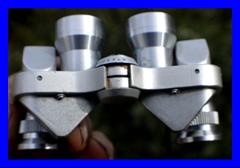
|
Japanese External Reverse Porro Prism Binoculars. On line MUSEUM |
|
Nippon Kogaku Kogyo NIKKO MIKRON Binoculars. 日本光学工業株式会社 Mikron 小型双眼鏡 . |
|
While the origin of the miniature external reverse porro prism binoculars design of 1919 (Fata Morgana by Alfred Baumann) came from the post WWI German optical industry, the Japanese Nikko Mikron 6x by Nippon Kogaku followed in 1921. Fata Morgana production disappeared in the German economic chaos of the mid 1920’s, butJapanese production continued in small quantities by various companies until WWII, and surviving interwar examples are uncommon and coveted both in Japan and elsewhere. But this design primarily owes it’s volume, popularity, production, manufacturers, and brands to the immediate post WWII occupation mandate for the Japanese optical industry to produce exports as part of reconstruction, with production continued through the rest of the 1950’s and 1960’s and 1970’s in response to consumer demand for this design of binoculars that offered a novel miniature configuration which still performed on a level not far below that of full sized prism binoculars five times their size. And this design is still in more limited production in much the same form nearly 100 years later. |
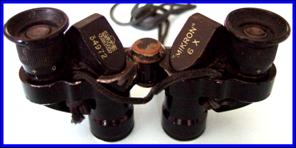
|
Japanese NIKKO MIKRON 6x binoculars made by Nippon Kōgaku Kōgyō Kabushikigaisha . Serial no 34972. The logo “NIKKO” was used 1921-1945; this second variation of the logo was used 1932-1945. Collection of Nico Westphal, Netherlands, binoculars from UK. Photos: Nico Westphal |
|
This seminal Japanese miniature binocular brand and design design was made between the world wars as NIKKO by Nippon Kōgaku Kōgyō Kabushikigaisha ( 日本光学工業株式会社 ). (today this company is Nikon). |
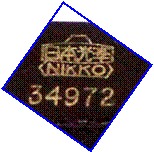
|
Miniature Binoculars and JAPAN (and Nikon). 小型双眼鏡 と日本 ( 本光学工業株式会社) . Miniaturferngläser und Japan (und Nikon). Jumelles miniatures et le Japon (et Nikon). Миниатюрные бинокль и Японии (и Nikon). Los Prismáticos en Miniatura y el Japón (y Nikon). Binocoli Miniatura e Giappone (e Nikon). |
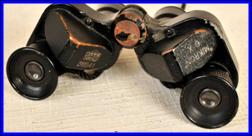
|
Japanese NIKKO MIKRON 6x binoculars made by Nippon Kōgaku Kōgyō Kabushikigaisha with Original case . Serial no 36541. Second variation “NIKKO” logo used 1932-1945. Collection of Mike Symons, British Columbia, Canada, Photos courtesy of Mike Symons |
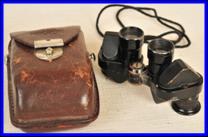
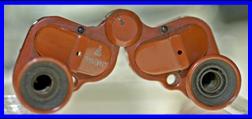
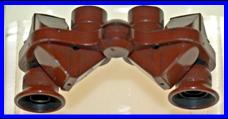

|
These binoculars are believed to be a pre production prototype model from around 1921 of the Japanese MIKRON 6x binoculars made by Nippon Kōgaku Kōgyō Kabushikigaisha. Note reinforcing band on prism cover9arrow). Only example known with that and in this color. No serial number. Collection of Nikon Corp , 株式会社 ニコン, Kabushiki-geisha Nikon. All photos courtesy of Hans Braakhuis, all rights reserved (middle photo is sectional enlargement of left hand photo) Noted Nikon historian and authority Hans Braakhuis took these photographs at the Nikon Ohi West factory during a visit in 1977 |
|
Early Nippon Kogaku Kogyo “MIKRON” miniature binoculars . 日本光学工業株式会社 « Mikron » 小型双眼鏡 Frühe Produktion Nippon Kogaku „MIKRON“ Mini Fernglas, Начало производства Nippon Kogaku “«MIKRON » . миниатюрные бинокль, Producción Tmprana en Miniatura Nippon Kogaku «MIKRON» Prismáticos. Binocolo in ura Nippon Kogaku «MIKRON» in Anticipo. |
|
Japanese NIKKO MIKRON 6x binoculars made by Nippon Kōgaku Kōgyō Kabushikigaisha . Serial no 39554. Second variation “NIKKO” logo used 1932-1945. Collection of Mark Ohno, USA, binoculars obtained in Victoria, British Columbia, Canada |
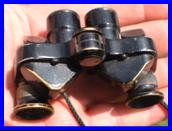


|
Japanese NIKKO MIKRON 6x binoculars made by Nippon Kōgaku Kōgyō Kabushikigaisha with original case (with broken catch) . Serial no. 36110. Second variation “NIKKO” logo used 1932-1945. Collection of Mark Ohno, USA, binoculars obtained in the UK. |

|
Logo of Nippon Kōgaku Kōgyō Kabushikigaisha 1917-1932 |
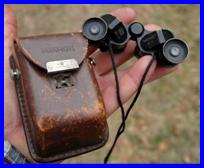
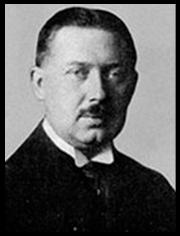
|
Ryuzo Fujii of Nippon Kogaku |
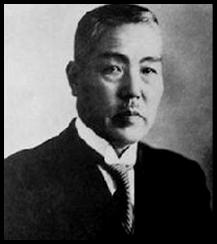
|
Heinrich Acht, German engineer at Nippon Kogaku, 1921-1928 |
|
Japanese NIKKO MIKRON 6x binoculars made by Nippon Kōgaku Kōgyō Kabushikigaisha . Serial no 39738 ca 1932-1945. Captured as a war trophy during the Battle of Saipan, Mariana Islands July 1944 by 19 year old Dewain Clift, I believe a member of the U.S. 708th Amphibian Tank Battalion, probably obtained from a deceased member of the Japanese 43rd Div. Collection of Mark Ohno, USA, binoculars obtained in the USA. Though taken as a result of a battle, this represents a soldier’s personal item and not military issued equipment. (Similar to the “meatball” Japanese flags signed by well wishers that many Japanese soldiers carried). |
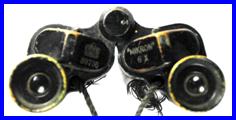
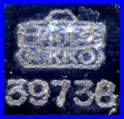

|
Japanese NIKKO MIKRON 6x binoculars made by Nippon Kōgaku Kōgyō Kabushikigaisha with Original case . Serial no 37803. Second variation “NIKKO” logo used 1932-1945. Unusually good original condition. Collection of Mark Ohno, binoculars obtained in the USA. Appreciate the assistance of William Kinzalow of Georgia USA for the acquisition of these binoculars. |
|
Amtrak amphibious tanks/tractors during battle of Saipan, June/July 1944 |
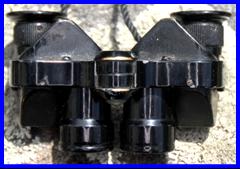
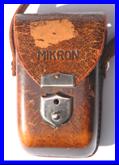
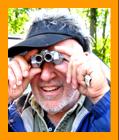


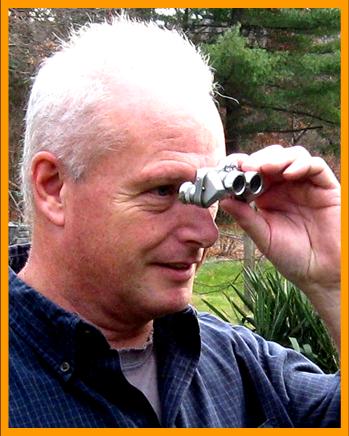
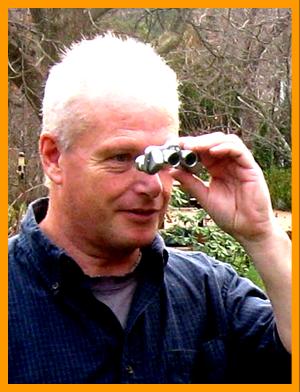
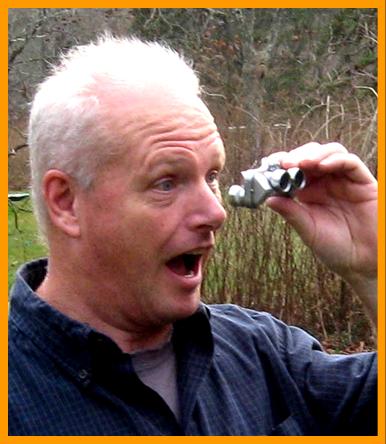
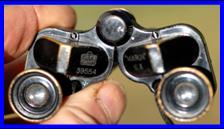
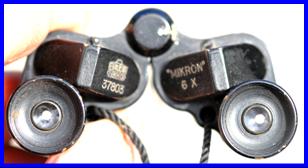
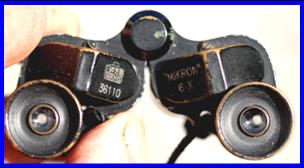
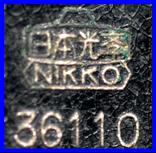

|
CONTACT US WITH INFORMATION OR COMMENTS: miniature.binoculars@gmail.com |
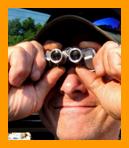
|
A Geopolitical History of Binoculars. Ein Geopolitische Geschichte des Fernglases. Une Histoire Gèpolitique des Jumelles. Урок истории . 歴史 レッス. Une Historia Geopolítica de Los Prismaticos. Una Storia Geopolitica dei Binocoli. |
|
Though largely absent from US school lessons, Japan declared war on Germany in WWI on Aug. 1914, three years before the US did in April 1917. Japan assisted Australian and NZ troops capture the Caroline, Mariana, & Marshall islands from Germany. Japanese marines helped British troops suppress a mutiny by Indian troops in Singapore; sent ships to help guard South Africa and Malta; and in 1918 joined US troops supporting white Russian armies against red armies in Siberia. My great uncle, a British citizen, (but not Irish) joined the 2/18 London Rgt: the 2nd London Irish Rifles (a UK Territorial Army unit) upon the British declaration of war in 1914. He carried a Japanese Arisaka rifle from Sept 1914 until Jan. 1916, when Short Magazine Lee Enfield rifle production caught up (the British purchased 150.000 Japanese type 30 & 38 rifles). When he was shipped to Egypt & Palestine to fight Turkish forces, his British convoy was protected by a Japanese destroyer. This illustrates the Anglo Japanese alliances that lasted from 1894 to 1923, and were only withdrawn due to heavy U.S. pressure (US plans for war with Japan “War plan Orange” was initiated in 1906, and was formally adopted in 1924). Japanese/UK relations remained good until the Tiensin Incident in China in 1939. These political and trade relations are the reason that Japanese miniature binoculars from between the world wars often turn up in the UK and the Commonwealth. Japanese [naval] military experience heavily influenced Japan’s optical industry. During the First Sino Japanese war of 1894-1895 Japan destroyed the Chinese Beiyana fleet. During the Russo Japanese war of 1904-1905 Japan destroyed 3/4 of the Russian fleet at the battle of Tsushima Straight. Key factors influencing success in naval battles as regarding optics is achieving earliest optical detection of the enemy; accurate ranging; superior gunnery due to optical targeting & ranging & trajectory calculation; and achieving quick gunnery corrections based on optical observation of shell fall. The famous pictures of Admiral Togo in the Russian Japanese war in 1905 show Togo on the British built battleship Mikasa holding German Zeiss binoculars and standing in front of a British Barr and Stroud optical rangefinder. This conspicuous dependence on foreign equipment is probably why just prior to the conclusion of WWI the Japanese government undertook a concerted effort to develop an advanced domestic Japanese optical and optical glass and optical weapons industry. Germany previously dominated those industries. Nippon Kōgaku Kōgyō Kabushikigaisha was created on July 25 1917 to be an optical weapons manufacturer, by merging the optical measuring division of Tokyo Keiki Seisaku-sho, the reflector division of Iwaki Glass Seizo-sho, plus Fujii Lens Seizo-sho. In July of 1919 while traveling in newly defeated Germany, Ryuzo Fuji (who studied optics in Germany for 3 yrs prior to 1900) recruited eight German engineers under a 5 year contract to work for Nippon Kōgaku KK, and the engineers arrived in Japan in January 1921. (per Nikon Corporate histories) They included Ernst Bernick, Hermann Dillmann, Karl Weise, Albert Ruppert, Max Lang, Adolf Sadtler and Otto Stange, working under Heinrich Acht. (Lang and Stange died in Japan in 1923 and 1924 respectively. Bernick, Dillmann, Weise, Sadtler & Ruppert returned to Germany in 1926, and Acht in 1928). Four German engineers were assigned to the 3 year old Ohi factory in the Ō district of Shinagawa-ku Tokyo, and four to the Shiba factory. While they worked on military oriented lenses, lens polishing, and processes, they also helped develop microscopes, camera lenses, and in 1921 they developed the [civilian] miniature Mikron 4x and 6x external reverse porro prism binoculars. These were of a very similar configuration to, and almost certainly were inspired by the German Fata Morgana and Optistar binocular design of 1919. These are sometimes called Nikon’s “first binoculars”, and are so in terms of being a company design. Actually Nippon Kōgaku KK inherited a number of conventional binoculars models and brands from Fuji Lens (such as the Asahi, Fuji, Yamato, Sakura, Nippon models) plus an opera glass and the Victor export model which was renamed Tenyu under the new company, and was primarily a military model. Some Nippon Kōgaku KK binoculars of various types initially appear branded as “ JOICO ” (though not the miniatures) which is believed an abbreviation of “ J apan O ptical I ndustries Co rporation”, which in turn is a westernized translation of Nippon Kōgaku Kōgyō Kabushikigaisha and other models appeared branded as “ NIKKO ” (including miniatures). According to a historical document held by Anna & Terry Vacani, the brand Nikkō ( 日光 ) appears to have been used on binoculars from 1927-1950. NIKKO is believed to be an abbreviation of the romanji name Ni ppon K ōgaku Kō gyō. Nikkō also means “sunlight”: 日 means sun. 光 means light. Which also invokes a patriotic component, as the Japanese name for “Japan” is Nippon or Nihon ( 日本 . ), which means “origin of sun”. Certain binoculars, including the miniature binoculars, were also branded “ Mikron”, which is a Greek word indicating miniature or small size. The company reportedly produced over 21 variations of their miniature reverse porro miniature binoculars over the next 96 or so years, and these are generally regarded to be among the highest quality and most desirable of this type of binocular. A center focus (CF) model was developed in 1948 for the US market, which preferred center focus binoculars, and which was the largest and most affluent market immediately after World War II. While my research on the origins of the design proves the German Fata Morgana binoculars were developed prior to the Japanese Mikron binoculars, and were presumably the inspiration for the Japanese designs, my search of Japanese patent databases gives no indication that Alfred Baumann ever patented his designs in Japan. Nor does it seem likely that the Nippon Kōgaku Mikron miniature designs were initially intended to be or were marketed outside Japan until long after all the Fata Morgana and Optistar and their European and US patents were long defunct. The Fata Morgana (indirectly), and the miniature Nippon Kogaku logo “MIKRON” and “NIKKO MIKRON” 4x and 6x binoculars were the direct precursors of a limited number of similar ultra small prismatic binoculars with form fitting external prism covers that were produced in Japan between the world wars. They were produced for export in large quantities in the last years of the 1940’s and in the 1950’s (including from around 1948 in the occupied Japan period of 1945-1952) as well as in the 1960’s, 1970’s, 1980s, and to a lesser degree subsequently. While I refer to these binoculars as “miniature”, and most were, some models were scaled up to be full size or even to be rather large binoculars (Simor, Vixen, & Super Zenith in 15x50), particularly for the UK & European markets. The design was also widely used for monoculars, and occasionally for spotting scopes. Some binoculars of this design are still actively produced. And Nikon released “anniversary models” of the original Mikron 6x15 binoculars in 1997 (albeit with center focus and modern coatings), and they are still in production, available, and quite popular and very well regarded in 2019, ninety eight years after their initial introduction. |
|
Documented Serial Numbers of NIKKO Mikron 6x Pre War Binoculars. 我々 が知っているシリアル番号 . 「 Nikko Mikron 」 6x 小型双眼鏡 . „ NIKKO MIKRON“ 6x Fernglas: Seriennummern, Die Beobachtet Wurden. «NIKKO MIKRON» 6x бинокль : Серийные номера мы документально. NIKKO MIKRON» 6x Jumelles: Les Numéros de Série Nous Avons Documenté. «NIKKO MIKRON» 6x Prismáticos: Los Números de serie Hemos Documentado. Numeri di Serie Documentatai di Binocoli «NIKKO MIKRON» 6x pre-Guerra. |
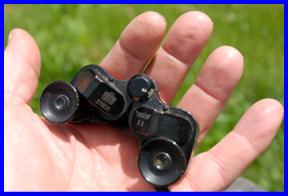

|
We thought it might be interesting to document the serial number range of known Nikko Mikron 6 x binoculars (Nippon Kogaku pre Nikon). Please add information to this database if you are able. もしあなたが有能であるなら、このデータベースにインフォメーションを加えてください。 Bitte fügen Sie die Informationen zu dieser Datenbank, wenn möglich. Veuillez fournir des informations pour cette base de données, si possible. Sírvanse proporcionar información para esta base de datos, si es possible. |
|
No serial number: brown, no SN, logo used pre 1930, Nikon Corp. Collection, pre Nikko Serial #2700 Japanese website Arrow Camera weblogs, logo used pre 1930, pre Nikko Serial #32992 auctioned in Japan 2015 Serial #33085 observed on Japanese web site Serial #33478 auctioned in Japan 2017 Serial #34972 collection of Nico Wesphal, Netherlands Serial #35197 observed on Japanese auction web site Serial #35237 observed on Japanese blog Serial #35766 observed on Japanese auction web site Serial #36110 collection of Mark Ohno, USA (obtained from the UK) Serial #36367 auctioned in Japan 2019 Serial #36541 collection of Mike Symons, BC, Canada Serial #36609 auctioned japan in 2018 Serial #36711 auctioned in UK in 2011 Serial #36763 collection of Mark Ohno, USA (obtained from the UK) Serial #36922 auctioned in UK Oct 2015 Serial #37287 auctioned in Japan Serial #37803 collection of Mark Ohno, USA (obtained in the USA) Serial #38842 held in collection in Japan Serial #39208 held in collection in Japan 2015 Serial #39236 auctioned on Ebay in the past Serial #39240 auctioned in Japan 2018 Serial #39268 auctioned in Japan 11/2014 Serial #39554 collection of Mark Ohno, USA (obtained from Canada) Serial #39738 collection of Mark Ohno, USA (obtained in USA/ captured at Saipan WWII) |
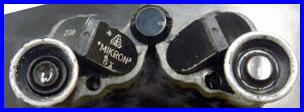
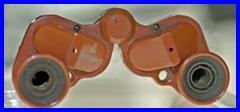

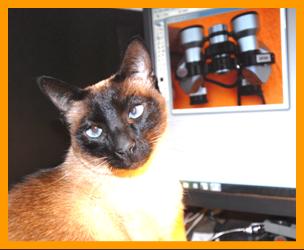

|
You promised pictures of mice and birds...not just boring miniature binoculars... |
|
Archetypal Nippon Kogaku 1950’s Mikron Binoculars Archetypal Nippon Kogaku 1950’s Mikron Fernglässer. Jumelles Mikron des Annèes 1950 de Nippon Kogaku. Архетипических Nippon Kogaku 1950 году Микрон Бинокль. 原型日本光学 1950 年代 のミクロン双眼鏡 Arketypisk Nippon Kogaku 1950 Mikron Kikare. Archetypische Nippon Kogaku 1950 Mikron Verrekijkers. Binoculares Arquetipo Nippon Kogaku 1950’s Mikron. «Archetypal» Nippon Kogaku 1950’s Binocolo Mikron. |
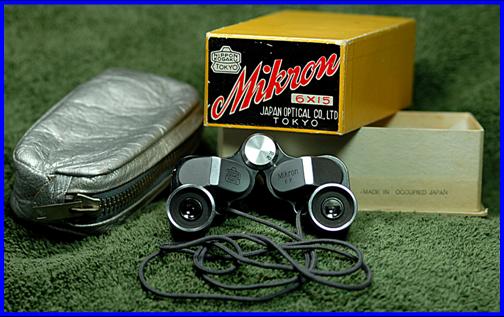
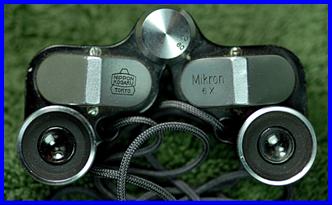
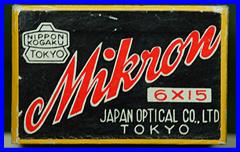
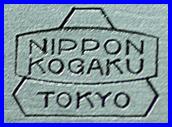
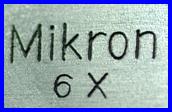
|
Pre-1930 MIKRONs (Earliest Nippon Kogaku logo and no Nikko brand name) |
|
Nippon Kogaku Mikron 6x Binoculars (6x15). Serial number 5041822. Collection of Mark Ohno. Sourced in USA . |
|
These are the classic post war Nippon Kogaku Mikron binoculars. They were manufactured around 1950-1952 during the occupation. The boxes were marked “Japan Optical Co. Ltd.”, which was a literal English translation of “Nippon Kogaku KK’’. The name “Japan Optical Co. Ltd.” was used after the war in the 1950’s on box labels and literature (though not as far as I know engraved on products). These binoculars were provided with soft leather clamshell zip cases in the colors of Silver, Red, Black, and Brown. The pristine binoculars illustrated above with their silver zipper case also has a silver neck cord. Both binoculars and box are marked “occupied Japan”. |
|
Archetypal Nippon Kogaku 1950’s Mikron Binoculars. Exportation Requirement Marked . Archetypal Nippon Kogaku 1950’s Mikron Fernglässer. Export Anforderung Markiert. Jumelles Mikron des Annèes 1950 de Nippon Kogaku. Exigence D'exportation Marquée. Архетипических Nippon Kogaku 1950 году Микрон Бинокль. Указание на экспорт. 原型日本光学 1950 年代 のミクロン双眼鏡.輸出要件がマークされています。 Arketypisk Nippon Kogaku 1950 Mikron Kikare. Exportbehov Märkt. Archetypische Nippon Kogaku 1950 Mikron Verrekijkers. Uitvoervereisten Gemarkeerd. Binoculares Arquetipo Nippon Kogaku 1950’s Mikron. Requisito de Exportación Marcado. «Archetypal» Nippon Kogaku 1950’s Binocolo Mikron. Requisito di Esportazione Segnato. |
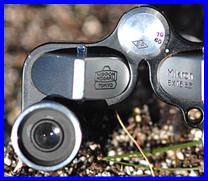
|
EP marking of “Export Required” goods. |
|
These are the classic post war Nippon Kogaku Mikron binoculars. These particular ones were manufactured right after the occupation, perhaps 1953-1955 or so. The boxes were marked “Japan Optical Co. Ltd.”, which was a literal English translation of “Nippon Kogaku KK’’. The name “Japan Optical Co. Ltd.” was used after the war and during the occupation and right after the occupation in the 1950’s on box labels and literature The pristine binoculars illustrated above had the molded brown hard leather clamshell zipper case that came after the soft pouch. The binoculars and box and leather case are each marked “ EP ”; the marking for products for export only. Manufactured products that were exported were exempt from domestic tariffs in occupied Japan and were sometimes marked with export only markings required to prevent black market domestic sale. There has been debate over the meaning of the initials of the “ EP ” of the export only markings on Japanese products, where manufacturers were allowed to deduct 80% of the value of export goods from taxes. This made separation of domestic market and export market goods a priority. My original research indicates that “ EP ’ almost certainly stands for “ E xport P roperty”, which is a defined state in US Customs Law (see US 26CFR1.993-3 for an example). SCAPIN closely followed US precedents in most matters in setting up post WWII Japanese occupation administration, which makes this terminology exceptionally probable. |



|
Nikon 60th Anniversary Model 7x15 Miniature Binoculars, with 1930’s Mikron Binoculars. 2014 Nikon 60 Jahre 7x15 Miniatur Fernglas, Mit Mikron Fernglas aus den 1930er Jahren. 2014 Nikon 60e Anniversaire 7x15 Miniature Jumelles, Avec Mikron Jumelles à Partir de 1930. 2014 Nikon 60-årsjubileum 7x15 Miniatyr Kikare, Med Mikron Kikare från 1930-talet. 2014 Nikon 60o Aniversario 7x15 Miniatura Prismáticos y Mikron Miniatura prismáticos de la década de 1930. Nikon 60°Anniversario Modello 7x15 Binocolo in Miniatura, con il Binocolo Mikron del 1930. |
|
1997 was the 60th anniversary of initial production of Nippon Kogaku’s 6x Mikron miniature binoculars. Commencing in 1997, Nikon reintroduced a new range of these models, both as limited edition commemoratives (2000 Champagne Edition) and production 6x15 and 7x15 CF models. In 2014, I purchased a new M type center focus (MCF) 7x15 Nikon Mikron in black, and subsequently another in silver, primarily to be able to photograph one next to one of our 1930’s Nikko Mikron 6x binoculars. I do like the optics of the new binoculars, but find I prefer the solid heft of the originals to the toy like weight of the all aluminum modern ones. I subsequently purchased a used silver 6x15 model. And then in 2015 I also purchased a year 2000 Champagne special edition set which was obtained in Japan, and not intended for export (all accompanying instructions in Japanese). |
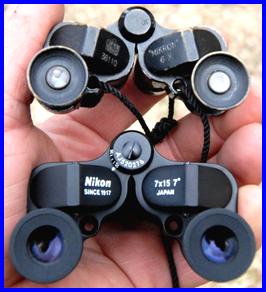
|
Pre WWII Nikko Mikron 6x binoculars top, “anniversary” black Nikon 7x15 binoculars below. Collection of Mark Ohno |
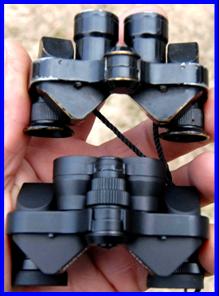
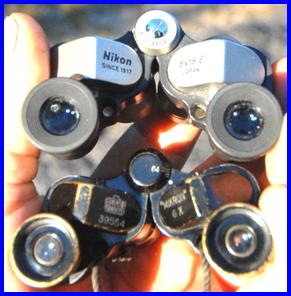
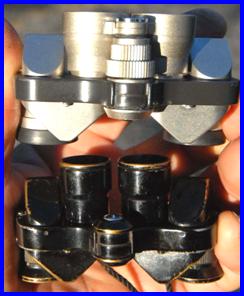
|
Current “anniversary” silver Nikon 6x15 binoculars top Pre WWII Nikko Mikron 6x binoculars below. Collection of Mark Ohno |
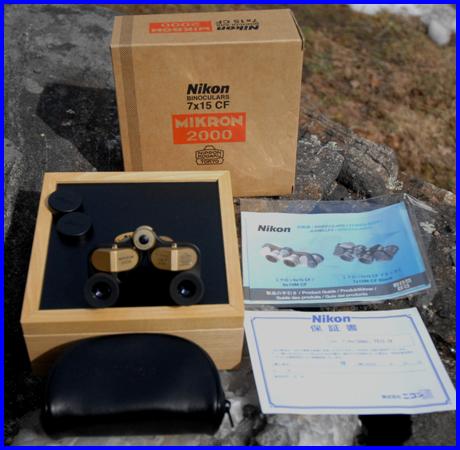
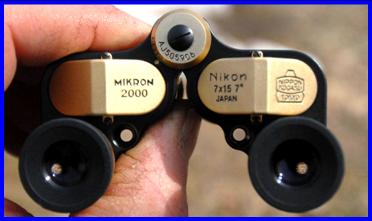
|
Limited Edition Nikon”Mikron 2000” 7x15 binoculars Collection of Mark Ohno. Sourced in Japan Supposedly 2,000 manufactured during 2000 & 2001. |
|
Limited Edition Nikon”Mikron 2000” 7x15 binoculars Collection of Mark Ohno. |
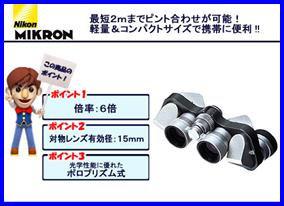
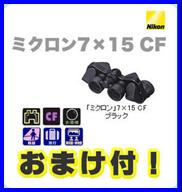
|
Dealer/ distributor advertisements for Nikon 7x15 binoculars |
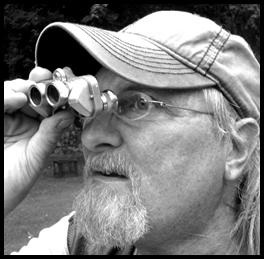
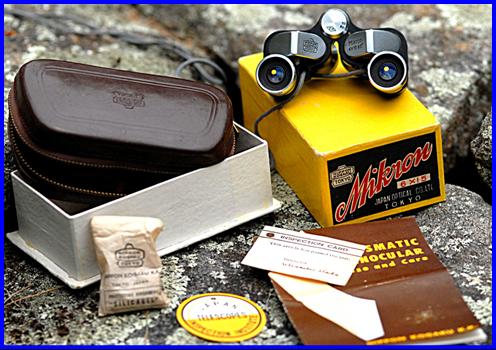



|
EP ink stamp on bottom of box |

|
EP imprint on leather case |
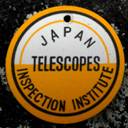
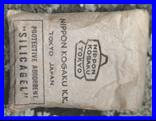
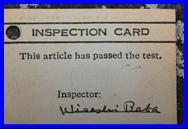
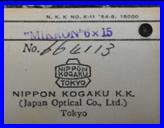
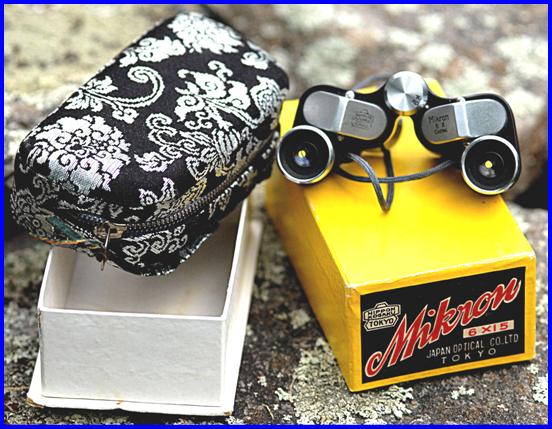
|
Nippon Kogaku Mikron 6x15 Binoculars. Serial number 664113 collection of Mark Ohno. Ca 1953-1955 |
|
Nippon Kogaku Mikron 6x15 Binoculars. Serial number 90110347. Collection of Mark Ohno. Believed mid 1950’s. |
|
T he Nippon Kogaku 6x15 Mikron binoculars at left postdate Nippon Kogaku’s occupation period binoculars: probably mid 1950’.s Willoughbys camera was advertising “Nikon” rather than Nippon Kogaku binoculars as early as Sept 1956. These feature a patterned cloth zip case intended to appeal to the female consumer to a greater degree than the more common brown molded hard leather zippered clamshell that was standard for these binoculars at that time might have done. |
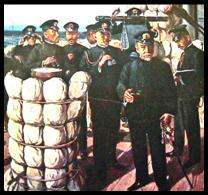
|
Admiral Togo on the British manufactured battleship Mikasa holding German Zeiss binoculars and standing in front of a British Barr & Stroud gunnery rangefinder. |

|
British WWI soldier armed with substitute standard Japanese Arisaka type 30 rifle |
|
Archetypal Nippon Kogaku 1950’s Mikron Binoculars Archetypal Nippon Kogaku 1950’s Mikron Fernglässer. Jumelles Mikron des Annèes 1950 de Nippon Kogaku. Архетипических Nippon Kogaku 1950 году Микрон Бинокль. 原型日本光学 1950 年代 のミクロン双眼鏡 Arketypisk Nippon Kogaku 1950 Mikron Kikare. Archetypische Nippon Kogaku 1950 Mikron Verrekijkers. Binoculares Arquetipo Nippon Kogaku 1950’s Mikron. «Archetypal» Nippon Kogaku 1950’s Binocolo Mikron. |
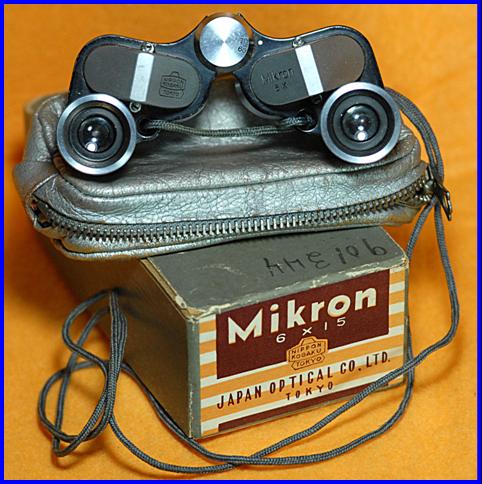
|
Another set of occupied Japan Nippon Kogaku 6x15 Mikron binoculars, serial number 901,344 with a more plain and less colorful box design. It is unclear if this relates to different boxes for different intended markets, or to a progression of box graphic designs by date, but probably boxes got more colorful later in production. As is observed on a number of early Nippon Kogaku binoculars boxes, the serial number is written in pencil on the outside of this box. The purpose of this is unknown, but it suggests some form of tracking of binoculars by serial number for some portion of the export and import and distribution process. It is known that in the early part of the 1950’s there was quite a considerable concern that tax exempt export binoculars not be diverted into the domestic black market, as evidenced by export only binoculars and box markings. It is likely that some tracking of export market versus domestic binoculars by serial number may have occurred to prevent diversion of non taxed export intended binoculars, and that these serial number records were made from the box exterior rather than having to open and unpack the binoculars and read the serial number directly from the binoculars. |
|
Nippon Kogaku Mikron 6x15 Binoculars. Serial number 901,344. Collection of Mark Ohno. |
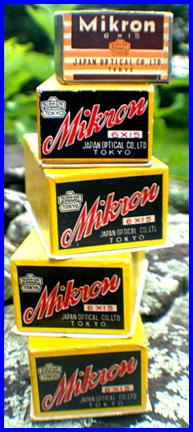
|
Uncommon in 2019. 1950’s binoculars boxes. |
|
BINOCULARS RESEARCH WEBSITE, NOT FOR PROFIT FERNGLAS-FORSCHUNGS-WEBSITE, NICHT GEWINNORIENTIERT SITE DE RECHERCHE SUR LES JUMELLES, À BUT NON LUCRATIF |
|
MARK OHNO ミニチュア双眼鏡 миниатюрные бинокли |
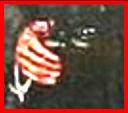
![Text Box: CLICK ON PAGE LINE. CLIQUEZ SUR LA LIGNE DE PAGE. KLICKEN SIE AUF SEITENZEILE. HAGA CLIC EN LÍNEA DE PÁGINA..[ページ行]をクリックします。НАЖМИТЕ НА СТРОКУ СТРАНИЦЫ. ALSO SEE INDEX.](image6052.gif)

|
GENERAL WEBSITE UDATE December 19, 2025 AS OF 12/1/9/2025 37,511,479 VIEW S OF WEBSITE |